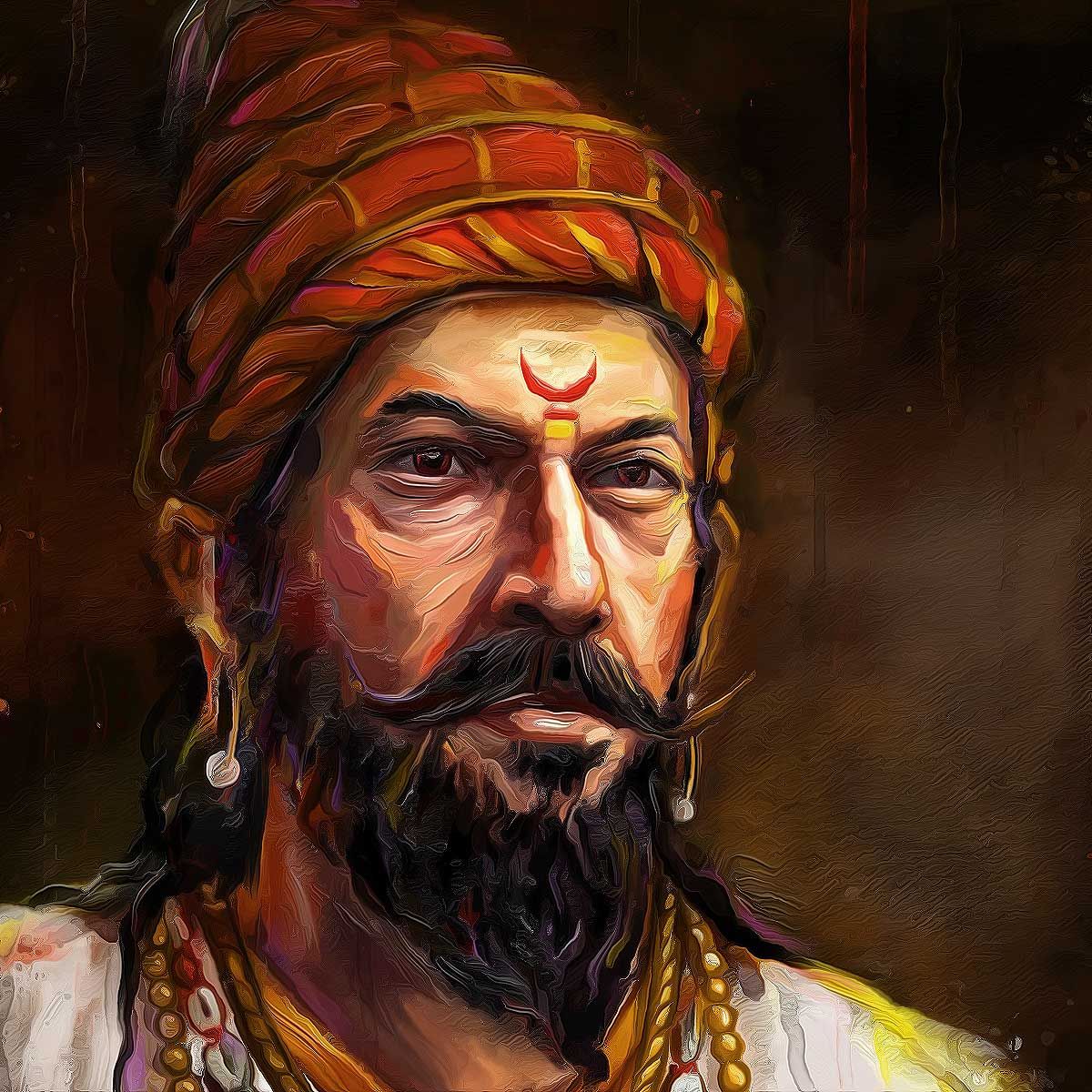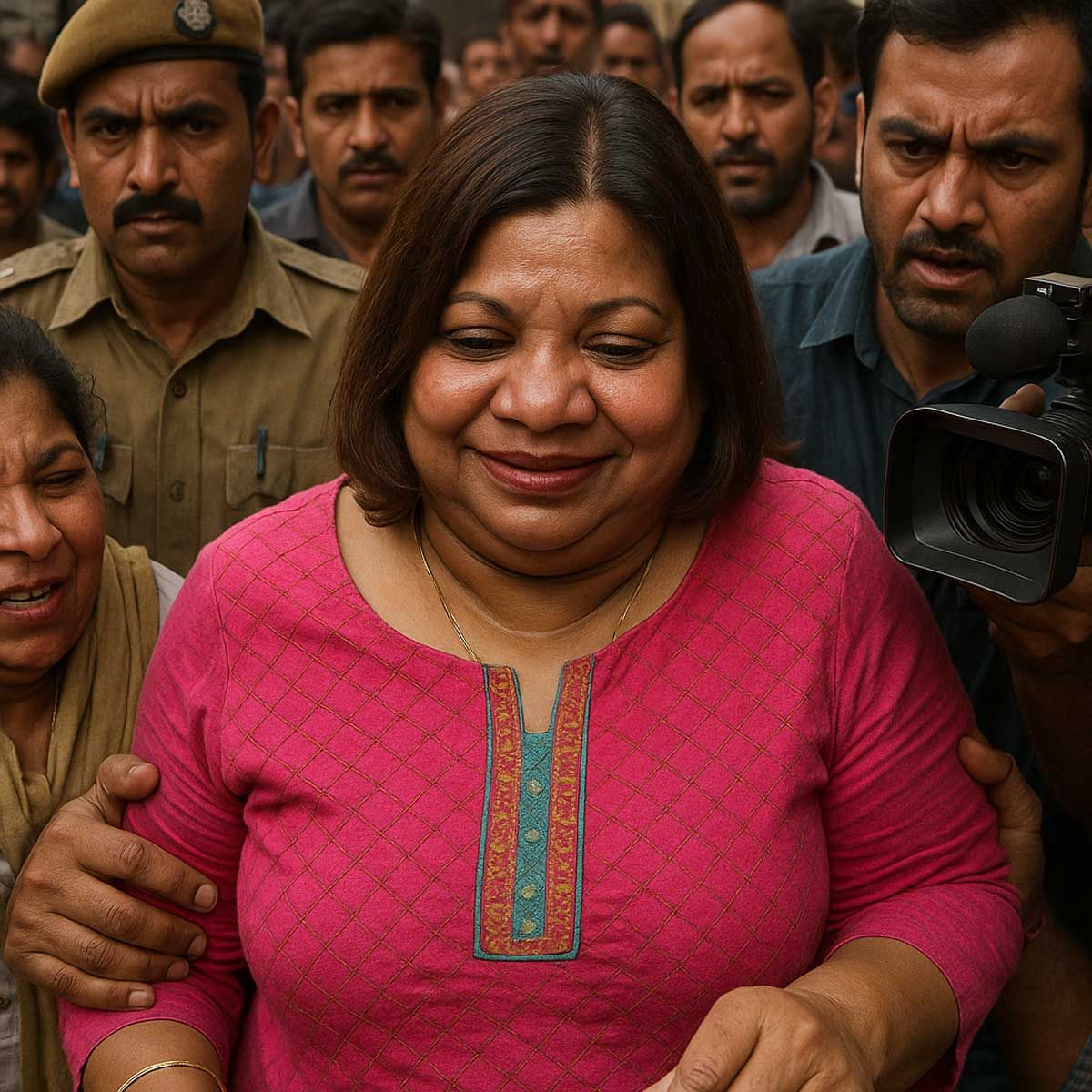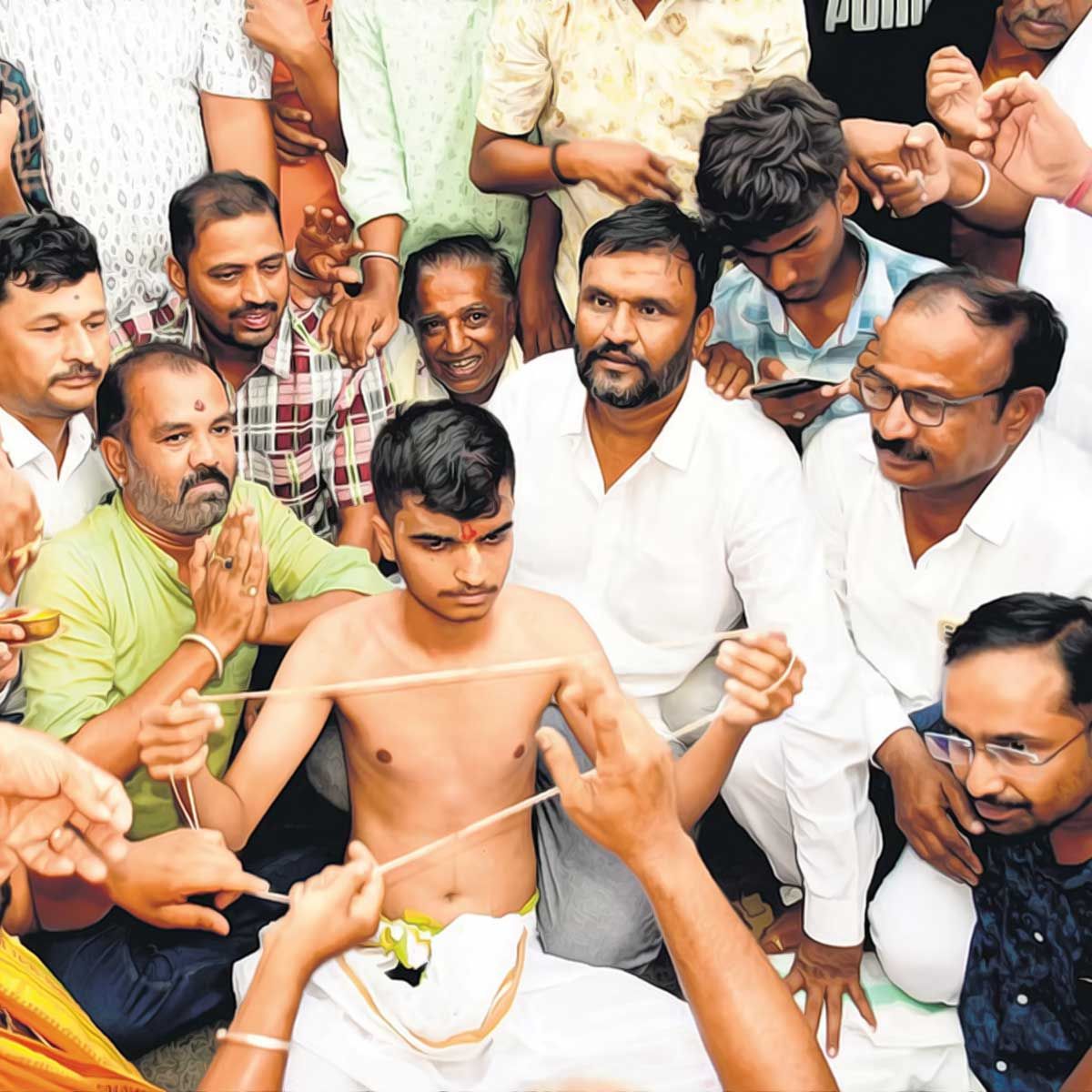More Coverage
Twitter Coverage
Satyaagrah
Written on
Satyaagrah
Written on
Satyaagrah
Written on
Satyaagrah
Written on
Satyaagrah
Written on
JOIN SATYAAGRAH SOCIAL MEDIA
In a historic move, Maharashtra rejoices as Shivaji Maharaj's iconic weapon, the 'Wagh Nakh', making its triumphant return from the UK, relive the tale of this legendary weapon, embodying Shivaji's strategic genius and India's rich martial heritage

In a monumental moment that is reverberating with the sounds of roaring pride and triumphant nationalism, the illustrious "Wagh Nakh", the legendary weapon wielded by the great Chhatrapati Shivaji Maharaja, is poised to make its grand homecoming from a London museum back to the soil where it first etched its place in history - Maharashtra. This awe-inspiring weapon, whose name translates to 'tiger claws', has been a testament to the indomitable spirit of the Maratha king, a symbol of his sheer might and fearless stance against tyranny.
Almost echoing through the annals of time, we revisit the heart-stirring moment on the 10th of November, 1659, when Shivaji Maharaja demonstrated an unparalleled display of military prowess. In a historic confrontation that has been recounted through generations, Shivaji Maharaja plunged the 'Wagh Nakh' into the oppressive Bijapur sultan Afzal Khan, liberating the land and its people from his merciless rule, a vivid tableau of bravery and valor that has been immortalized in the hearts of every Indian.
This revered artifact, which found its resting place in the hands of Shivaji Maharaja's descendants at the Satara court, once traversed seas, entrusted to the stewardship of East India Company officer James Grant Duff. A possession that once echoed the bravery of a king, found itself showcased in the halls of the Victoria and Albert Museum in the United Kingdom, following its donation by Duff's lineage.
Now, in a move that has stirred the hearts of citizens with a mélange of patriotism and emotional fervor, Maharashtra Cultural Affairs Minister Sudhir Mungantiwar is ready to step onto British soil to reclaim this priceless piece of Indian heritage. With the signing of a Memorandum of Understanding with the museum slated this month, the air is thick with anticipation and pride, as the 'Wagh Nakh' prepares to journey back home, to the land where it once changed the course of history.
There is a palpable excitement, a collective holding of breaths as the nation awaits the return of this monumental artifact, perhaps just in time to commemorate the historic day Shivaji Maharaja vanquished Afzal Khan. As Mungantiwar remarked, the timely repatriation of the 'Wagh Nakh' could provide the perfect backdrop to celebrate this historic anniversary, an event that would undoubtedly evoke a powerful surge of nationalism and pride across the nation.
Awaiting with bated breath, the people of Maharashtra stand ready to welcome home a fragment of their glorious past, a tangible representation of their forefather's heroic deeds, which stands as a beacon of courage, strength, and the indomitable spirit of the Indian nation.
In a stirring development that sends waves of elation across the nation, a letter from the UK authorities has ignited a beacon of hope and shared heritage. As the Maharashtra minister fervently articulated, “We have got a letter from the UK authorities saying they have agreed to give us back Chhatrapati Shivaji Maharaja’s Wagh Nakh." A development that not only symbolizes the return of a precious relic but also kindles a flame of unity and cultural resurgence.
|
With hearts swelling with pride and eyes glistening with reverence, the nation stands at the cusp of witnessing a historic reunion. The journey of the 'Wagh Nakh' back to its ancestral land is being orchestrated with immense reverence and meticulous planning. "We might get it back for the anniversary of the day when Shivaji killed Afzal Khan, based on the Hindu calendar. Some other dates are also being considered and the modalities of transporting the Wagh Nakh back are also being worked out," shared the enthralled minister, echoing the collective pulse of an exhilarated Maharashtra and its vibrant populace.
The sentiment resonates powerfully, as the minister emphasized, "The fact that the tiger claws are on the way back is a big step for Maharashtra and its people." In a symbolic gesture, the authorities are exploring the possibility of aligning the return with a date that holds profound significance in the Hindu Tithi calendar, thus imbuing this monumental event with spiritual resonance and an emotional depth that transcends generations.
But the glory doesn't stop here. The echoes of this triumphant initiative reverberate further, as the minister hinted at the potential repatriation of other legacy objects, including the iconic 'Jagadamba sword', another witness to Shivaji Maharaja's formidable reign, a testament to his valor and a symbol of Maharashtra's rich, unyielding heritage.
Detailing the grand plans further, it was unveiled that a government resolution has sanctioned a delegation comprising of Minister Mungantiwar, the principal secretary of culture Dr. Vikas Kharge, and Dr. Tejas Garge, the director of Maharashtra Directorate of Archaeology and Museums, to grace the halls of the Victoria and Albert Museum and other emblematic institutions in London. This powerhouse team, as stewards of Maharashtra's vibrant culture and history, will embark on a six-day mission from the 29th of September to the 4th of October, a journey allocated a fund of around Rs 50 lakh, a worthy investment in reclaiming a fragment of India’s illustrious past.
Thus, as the days count down to this monumental visit, the hearts of millions beat in unison, a symphony of excitement, nationalism, and fervent pride, anticipating a homecoming that promises to rekindle the fiery spirit of a hero whose legacy continues to inspire awe and reverence across generations.
|
What is the ‘Wagh Nakh’ or tiger claws?
In the annals of India's vibrant history, the stories of valiant warriors and their legendary weapons have echoed through time, inspiring generations with tales of courage and ingenuity. Among these legends stands the iconic 'Wagh Nakh,' a weapon so intimately tied to the person of Chhatrapati Shivaji Maharaj, that it almost seems like an extension of his formidable spirit, a testament to his brilliant military acumen and a symbol of the profound cultural resurgence he ignited.
As we delve deeper into the illustrious narrative, it is imperative to understand the genesis and craftsmanship of this unique weapon, a veritable extension of the warrior's own body, conceived and forged in the fires of ancient knowledge and tradition.
The 'Wagh Nakh,' or the tiger claws, finds its roots deeply entrenched in the vast reservoir of knowledge contained within the Dhanur Veda, an extensive treatise dedicated to the mastery of weaponry, combat and military sciences. Revered as an 'Amukt Shastra' in the sacred Agni Purana, a guiding text in the Maratha empire, the weapon personifies a seamless blend of utility and strategy, embodying the essence of an object that could be worn, a hidden extension of the warrior's body.
This ancient text serves as a window to a time where the art of warfare transcended mere physical confrontation, manifesting as a brilliant symphony of science, strategy, and spirituality. In this rich tapestry of knowledge, Chhatrapati Shivaji Maharaj found inspiration, reviving the lost art and ushering a new era of resurgence in Hindu civilization. A master tactician, he foresaw the potential betrayal by Afzal Khan and chose the 'Wagh Nakh' as his secret weapon, a silent guardian forged from steel and strategy, ready to strike at the opportune moment.
In a vivid depiction of ingenuity, the 'Wagh Nakh' emerges as a masterpiece of ancient Indian craftsmanship. Crafted meticulously with steel, it features four deadly claws mounted on a bar, coupled with two rings designed to fit snugly around the first and fourth fingers. Concealed effortlessly within the palm, the weapon boasted a design capable of penetrating skin, muscle, and even bone, a lethal combination of stealth and potency. Often laced with poison at the tips, it ensured a swift and fatal end to the enemy, a silent yet powerful testament to Shivaji Maharaj's visionary warfare technology that breached the sands of time, reviving an ancient glory in a world besieged by tyranny and deceit.
As we stand on the brink of witnessing a historic homecoming, the story of 'Wagh Nakh' transcends mere metal and craftsmanship. It embodies a spirited resurgence, a beacon of hope, and a living testament to a time when heroes walked the earth, wielding the power of intellect, strategy, and a profound connection to a rich and vibrant heritage. It stands as a remarkable testament to ancient India's military might, a beacon of the indomitable spirit and genius of Chhatrapati Shivaji Maharaj, a hero who carved a legacy from the annals of time, inspiring generations with his unwavering resolve and visionary leadership. It's not just a weapon returning home; it is a resurgence of pride, honour, and a glorious chapter of Indian history coming full circle.
|
How did Shivaji kill Afzal Khan using the tiger claws?
In an important chapter of Indian history, a significant event stands tall, echoing the prudence and courage of the legendary Maratha king, Chhatrapati Shivaji Maharaj. This tale, deeply rooted in the states of Maharashtra, Madhya Pradesh, and Karnataka, vividly illustrates Shivaji's forethought and strategic excellence during a crucial encounter with Afzal Khan, a formidable adversary from the Adilshahi dynasty in the Bijapur Sultanate.
Afzal Khan, a man with an imposing stature and an aggressive mission to defeat Shivaji, was known for his ruthless pursuits, including the merciless murder of Shivaji’s elder brother when the Maratha king was merely 13 years old. His destructive streak did not spare even the revered Hindu temples, which fell victim to his ire.
Foreseeing a potential betrayal by Khan during a proposed peace meeting, Shivaji Maharaj exhibited remarkable foresight and a deep understanding of human anatomy. He identified critical areas within his reach to strike Khan effectively - the abdomen and the liver. To ensure a successful counterattack, Shivaji chose the 'Wagh Nakh' or tiger claws, a weapon synonymous with the Maratha heritage, characterized by its stealth and potency. This weapon could easily be concealed as a set of rings on the fingers, ready to unleash a fatal assault at a moment's notice.
As the two met under the guise of a peace meeting, Shivaji Maharaj came prepared, predicting Khan’s deceit accurately. Despite the mutual agreement to come unarmed, Khan tried to attack Shivaji, a move that was anticipated. Thanks to the protection afforded by his armour and the readiness of the concealed 'Wagh Nakh', Shivaji managed to defend himself effectively, turning the tide of the confrontation firmly in his favour.
This confrontation marked a significant moment in history, where sheer wit met brute force, resulting in a victory that would be celebrated and remembered for generations. Shivaji’s ingenious use of the 'Wagh Nakh', coupled with his strategic planning, not only ensured his survival but also marked the decline of a tyrant who had wreaked havoc across the region.
This victory, celebrated across India, especially in Maharashtra, Madhya Pradesh, and Karnataka, serves as a stirring reminder of the rich history and vibrant heritage that embodies the spirit of India. It speaks volumes about the courage, intelligence, and indomitable spirit of Shivaji Maharaj, a true hero who walked the lands of India with pride and honor, leaving an indelible mark on the sands of time.
In a crucial encounter at the foothills of Pratapgarh, a meticulously devised strategy unfolded, spotlighting the astuteness of Chhatrapati Shivaji Maharaj. The geography of the location was a strategic choice by Khan, aiming to lure Shivaji into the open plains of the Deccan, where the rocky plateau would not provide Shivaji with a natural advantage.
Khan's forces greatly outnumbered the Marathas, boasting a staggering force of over 20,000 cavalry and 15,000 infantry compared to the 6,000 light cavalry and 3,000 light infantry under Shivaji's command. Despite this, Shivaji sought a peaceful resolution, sending an emissary to Khan with a message of non-aggression and a desire for peace.
Fully aware of Khan’s potential deceit, Shivaji took precautionary measures for their meeting, which was agreed to be unarmed, with only ten bodyguards accompanying each leader, maintaining a distance equivalent to the range of an arrow from the meeting point. The interaction began with a seeming display of camaraderie as Khan embraced Shivaji. This, however, swiftly turned into an attempted assassination as Khan unsheathed a sword in an attempt to strike Shivaji down.
The event, however, took a turn as Shivaji’s protective armor shielded him from the blade, averting potential fatal harm. With quick reflexes, Shivaji retaliated using the concealed 'Wagh Nakh', a weapon proficient in close-quarter combat. The ensuing scuffle saw Shivaji using the 'Wagh Nakh' expertly to fatally wound Khan, eventually leading to the latter's demise.
Despite being outnumbered, the Marathas displayed remarkable valor and skill in the battle that ensued, eventually emerging victorious against the formidable Adilshahi forces. This pivotal moment in history has been vividly portrayed in the Marathi movie "Sher Shivraj", providing a visual narration of the meticulous planning and courageous execution that marked Shivaji's victory over Afzal Khan, preserving the legacy and fortitude of the Maratha empire.
 Support Us
Support Us
Satyagraha was born from the heart of our land, with an undying aim to unveil the true essence of Bharat. It seeks to illuminate the hidden tales of our valiant freedom fighters and the rich chronicles that haven't yet sung their complete melody in the mainstream.
While platforms like NDTV and 'The Wire' effortlessly garner funds under the banner of safeguarding democracy, we at Satyagraha walk a different path. Our strength and resonance come from you. In this journey to weave a stronger Bharat, every little contribution amplifies our voice. Let's come together, contribute as you can, and champion the true spirit of our nation.
 |  |  |
| ICICI Bank of Satyaagrah | Razorpay Bank of Satyaagrah | PayPal Bank of Satyaagrah - For International Payments |
If all above doesn't work, then try the LINK below:
Please share the article on other platforms
DISCLAIMER: The author is solely responsible for the views expressed in this article. The author carries the responsibility for citing and/or licensing of images utilized within the text. The website also frequently uses non-commercial images for representational purposes only in line with the article. We are not responsible for the authenticity of such images. If some images have a copyright issue, we request the person/entity to contact us at satyaagrahindia@gmail.com and we will take the necessary actions to resolve the issue.
Related Articles
- “We realize the importance of our voices only when we are silenced”: BBC alias Biased Broadcasting Corporation witnessed 'Enough is enough' protest from Hindus for selective news coverage and biased narrative against India and Hindus in particular in UK
- “When did the future switch from being a promise to being a threat?”: Mob of 200 Muslims with chants of ‘Allahu Akbar…Takbir’ attacks Durga temple in Smethwick as cops look on after vandalizing a Hindu temple and desecrating a saffron flag in Leicester
- "When you start attacking cronyism and people's political interests, it gets nasty": Leicester violence - Muslims attack Hindus who were protesting against earlier violence by Muslims against Hindus, religious symbols used to identify and target Hindus
- "London's glitter hides its children's hunger": 1 in four children in the UK lack nutritious meals, amidst London's opulence, a stark hunger crisis emerges, revealing a G7 nation's disturbing reality, Akshaya Patra Foundation unveils these shocking stats
- "या अल्लाह": Sara Sharif, a 10-year-old from Woking, found dead with severe injuries; her father, Urfan Sharif, confessed to beating her but blamed stepmother Beinash Batool, as forensic evidence and messages revealed abuse, triggering trial at Old Bailey
- "Sunak, wake up": Hindu families terrorized by Islamists in West Midlands, spine-chilling details of relentless persecution, labeled ‘Kafir,’ but Police deny hate crime citing 'no evidence,' yet a recent case implicates a British Muslim cop in the torment
- "From tackles to turmoil: Kabaddi's UK saga": A joyous Kabaddi event turns sinister in Derby as masked men, swords in hand, interrupt the games. Amidst Khalistani flags, the game's spirit is overshadowed by the sound of clashes and screams
- 'Balasaheb has taught us – The one who challenges should be broken. Even Modi would not have been spared if he had challenged Matoshree the way Kirit Somaiya did': Shiv Sena leader Dipali Sayyed
- "Dignity, not Disrespect: The Call for Justice": During Ganesh Chaturthi in Leicester, a harrowing episode unfolded as a police officer exhibited stark misconduct towards an elderly Hindu priest, igniting widespread outrage and calls for immediate action
- "Important thing to know about an assassination is not who fired the shot, but who paid for the bullet": Iran plotted assassination on UK soil, tried to kill ten 'enemies of the regime' in Britain, MI5 warns of 'very real' threat posed by China and Russia
- Satyam Surana's harrowing experience at LSE, tainted by vicious smear campaign & blatant political bias, reflects a troubling trend of adversity tormenting Indian students like Rashmi Samant & Karan Kataria, exposing deep-rooted systemic issues in England
- From confronting domestic adversities to taking center stage at the British Parliament, the dynamic Indian women in the UK are redefining empowerment and making monumental strides, backed by the unwavering support of Inspiring Indian Women (IIW)
- "Be ashamed to die until you have won some victory for humanity": Queen Elizabeth II died at Balmoral aged 96, when she was coronated, UK held 70+ overseas territories as part of its empire, and her death sparked a multitude of feelings, often conflicting
- “Realize that everything connects to everything else”: Christians now a minority in England and Wales for the first time, Secularists and liberals question the position of an established church that gives bishops the right to sit in the House of Lords
- ‘They landed on Moon, don’t give them money’: Unable to overcome colonial narratives, British media "Mooning" over India's space success, the facts paint a different story, it's investments, not handouts; time for a reality check beyond the headlines




























